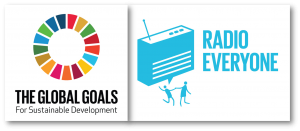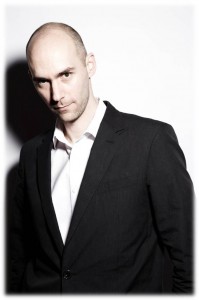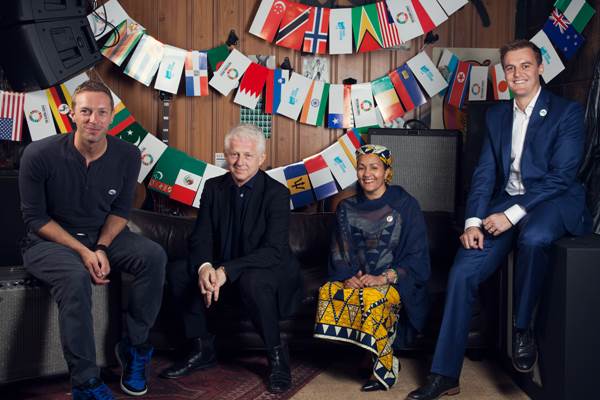As broadcasters, we consistently hear from Nielsen that radio reaches 90%+ of all U.S. consumers age 12 and up on a weekly basis. As impressive as that is, it doesn’t do justice to the power of our medium around the world.
Radio Everyone was a unique one-week project that set out to harness the worldwide power of radio to raise awareness of the United Nation’s Global Goals for Sustainable Development: a series of goals more than 190 countries committed to in an effort to make the world more equitable and sustainable within the next 15 years.
 Radio Everyone was part of a greater movement called Project Everyone, spearheaded by movie and television producer Richard Curtis. In addition to being known for movies like Four Weddings and a Funeral, Bridget Jones’s Diary, and Notting Hill, Curtis also co-founded Comic Relief and organized the Live 8 concerts with Bob Geldof.
Radio Everyone was part of a greater movement called Project Everyone, spearheaded by movie and television producer Richard Curtis. In addition to being known for movies like Four Weddings and a Funeral, Bridget Jones’s Diary, and Notting Hill, Curtis also co-founded Comic Relief and organized the Live 8 concerts with Bob Geldof.
His vision was to spread the word about the Global Goals to everyone on earth so that world leaders would be held accountable for taking the steps necessary to get results. It was a giant, multi-media effort with radio leading the way. To learn more about this ambitious project and the role radio played, we reached out to Piers Bradford, who led the Radio Everyone effort, to find out more about how the project came together and the impact it had.
JM: Please explain what Project Everyone was all about?
PB: On September 25, 2015 at the United Nations, 193 countries committed to 17 Global Goals for Sustainable Development in order to achieve 3 extraordinary things in the next 15 years:
- End extreme poverty.
- Fight inequality & injustice.
- Fix climate change.
Project Everyone was devised by Richard Curtis to make these goals famous. The thinking being that the more people that know about the goals, the more likely it is that leaders will be held accountable and ultimately that they will be fulfilled. So we set out with the ridiculous, but eye catching ambition, of reaching all 7 billion people across the world within 7 days of them being announced.
We looked at how to reach as many people as possible, as part of the wider Global Goals campaign, and identified a series of creative initiatives including:
- “The World’s Largest Lesson” – which was taught in over 103 different countries.
- The world’s first ever global cinema advert, made by Aardman and featuring the voices of Liam Neeson and Michelle Rodriguez.
- A partnership with the Global Citizen festival in NYC, starring Coldplay, Pearl Jam, Ed Sheeran, and Beyoncé. This was streamed on YouTube and then cut down into a TV show which was shown in 26 different countries.
- 136 flags raised from the North Pole to North Korea, Moscow’s Red Square to 10 Downing Street, Larke Pass in Nepal to Lira Town in northern Uganda.
- The biggest online sites, including Google, Bing, MSN, Baidu and many others, gave us home page presence.
- Mobile operators sent a text message to almost one billion people about the goals.
- A crowdsourced film: We The People – contributed to by Professor Stephen Hawking, Daniel Craig, Jennifer Lawrence, Kate Winslet, Meryl Streep, Robert Redford, Colin Firth, Stevie Wonder and many more.
And, of course, Radio Everyone, which ended up with partner broadcasters in 75 countries around the world.
JM: The website says radio “was at the forefront” of Project Everyone. Why was radio deemed to be such a large element of the overall plan?
 PB: UNSECO (the United Nations Educational, Scientific and Cultural Organization) figures estimate that 95% of the world’s population have access to a radio signal, and the penetration levels of radio listening across both developed and developing world countries is phenomenal. Our goal was to reach as many people around the world as possible, so it was something of a no-brainer to include a radio element in our plan.
PB: UNSECO (the United Nations Educational, Scientific and Cultural Organization) figures estimate that 95% of the world’s population have access to a radio signal, and the penetration levels of radio listening across both developed and developing world countries is phenomenal. Our goal was to reach as many people around the world as possible, so it was something of a no-brainer to include a radio element in our plan.
It also helps that Richard Curtis is a fan of the medium. He is a passionate consumer of radio, has made films featuring radio (The Boat That Rocked retitled Pirate Radio in North America), and has seen the power of radio to raise public awareness during his work with Comic Relief.
Finally, radio is an incredibly flexible form of communication with the power to affect listeners deeply.
JM: What resources did you make available for your radio partners?
PB: We quickly realised there wasn’t a “one size fits all” way to deal with radio stations around the world. So we put together a kit with parts that programme makers could incorporate into their programming. Their brief was to use this material whatever way worked best for their format and their audience.
The kit included:
- A bespoke sound package based around an original composition from Peter Gabriel, featuring the Soweto Gospel Choir and remixed by Benji B.
- A PSA series introduced by Chris Martin, Professor Stephen Hawking, and Liam Neeson.
- Content from the Global Citizen festival, including live tracks from Ed Sheeran and Coldplay.
- Short-form content from celebrities like Bill Gates and Leonardo DiCaprio.
- Full-length programmes produced by our partners, including BBC Music.
- Bespoke full length programmes fronted by people like Ice Prince, Rita Ora, Cate Blanchett, Bono, and Christiane Amanpour.
The material that was offered was available on a download site (specially created by ReelWorld), which broadcasters could browse through, preview the audio and download the assets that worked for them.
JM: What was the biggest challenge in putting the program together? And how did you overcome it?
PB: We were trying to make something famous that there was very little awareness of. So broadcasters wanted to know who else was on board and which “names” we had participating. Similarly, talent wanted reassurance that this was a worthwhile endeavour, and they would be in good company!
Furthermore, every radio station in the world is different: different audience demographics; different formats; and different editorial priorities. Most stations wanted something exclusive but to achieve any sense of scale we couldn’t offer that. Radio Everyone was open source content for any station in the world to use, as long as they used it to promote the message of the Global Goals.
I think it mainly worked through sheer doggedness and perseverance. Having Richard Curtis leading the project definitely helped enormously and so did the early enthusiasm of a few key broadcasters who believed we were going to pull it off.
The other crucial pieces were our brilliant partners who really made it happen. Working with agencies like the UNDP opened up countries we had no chance to reach. Record labels like Sony, Warner Brothers, and Universal were brilliant with their talent outreach. Brands like Unilever and Standard Chartered helped us source content in very unlikely ways.
JM: Were language barriers an issue?
PB: We created PSAs and production guides in 10 different languages. We also provided scripts and production elements so that broadcasters could produce their own. We had celebrities from Brazil (Gilberto Gil and Lenine), India (AR Rahman and Hrithik Roshan) and Hong Kong (G.E.M.) who presented shows in languages other than English. But I would have loved to do more.
My favourite broadcasters were those like RTL in Luxembourg, RAI in Italy, and Radio Romania. We didn’t produce any content in their native languages, but they were so keen to be involved that they produced their own. Conversely, we were definitely weak in the Spanish speaking world, and I put part of that down to the fact we didn’t offer enough content in Spanish.
JM: You had so many celebrities involved in the project. Run down who participated and tell us how you secured their help.
PB: The list includes Bono, Christiane Amanpour, Rita Ora, Jamie Oliver, Kasabian, Ice Prince, D’ Banj, Cate Blanchett and Andrew Upton, Paloma Faith, Haile Gebrselassie, Cody Simpson, AR Rahman, Hrithik Roshan, G.E.M., Hilary Swank, Aaron Taylor Johnson, Gilberto Gil, Criolo, Lenine, Peter Gabriel, and many others.

They came through all sorts of different routes. We had a fantastic talent booker, Richard asked, record companies asked, I asked, UN agencies asked, NGOs asked, and we had agencies working in key territories that identified and approached talent to ensure we had a truly global feel.
Being totally honest, it was incredibly tough to get people on board as we were asking quite a lot of them. We wanted them to not just be interviewed but host the shows themselves, and also to promote the message of the Global Goals within their programmes. There were times when I didn’t think it was going to happen, but I am fiercely proud of the shows we ended up with.
JM: Were you surprised by the response you received from broadcasters?
PB: Continually! Some were amazingly proactive and delivered the most exciting content. Major broadcasters like Deutsche Welle and CBC in Canada were great but smaller broadcasters in the Philippines, Kenya, and Indonesia also produced amazing bespoke content.
Others less so!
JM: Were you happy with the amount of U.S. broadcasters who took part or were you hoping for more?
PB: We had some fantastic partners – most notably WNYC and Public Radio International. We also had some support from college radio, orchestrated by the ONE campaign.
iHeartRadio also partnered with the Global Citizen Festival so although we didn’t manage to work with them directly on Radio Everyone, they were still very much involved in the wider Global Goals campaign.
But we were a team of three. With more time and resources available I would have loved to work harder to get US broadcasters on board. For the main part it was our fault, not theirs!
JM: Looking back, what surprised you most about the campaign?
PB: The global spread we were able to achieve. Radio Everyone was carried in 75 countries around the world and the online stream was heard in 117 different countries. From a standing start in January, I think that is an amazing achievement!
JM: Was there more exposure via broadcast or streaming audio?
PB: To get mass audience, we knew we had to be on traditional broadcast platforms. We had some great streaming partners and digital partners including Spotify, Mixradio, and Mixcloud which were great for drawing attention to our content via social media. But the numbers don’t compare to the hundreds of millions who would have been able to hear content on broadcast radio stations.
JM: Will this become an ongoing effort or was it a one-time thing?
PB: The initial plan was to give the Global Goals the best possible launch and to focus all of our efforts on that 7 day period, and between the different parts of Project Everyone, we reached an estimated 3 billion people around the world.
However, now it feels that we have only just started the job. The goals definitely aren’t ‘famous’ yet, so we should continue our efforts over the coming years to ensure they are as well known by ordinary people around the world as possible.
JM: What suggestions would you have for someone who wants to take on an ambitious project like this?
PB: Keep it simple! I definitely would simplify my core proposition if I was doing it again.
Work hard to get some advocates or spokespeople for your project. Once you have them, they will draw others on board.
Don’t rush to a solution. Speak to your network, contacts and potential partners and determine what might work for them.
Be prepared to compromise and work to maintain a balance between self-belief and willingness to adjust.
JM: If there are stations that want to get involved now, what should they do?
PB: For 2015, our efforts are done. But please feel free to get in touch as we start planning for 2016. I’m still in listening and planning mode for ways to make this an annual event, so feel free to commit early and help me shape 2016. There is no doubt that there will be a Global Goals Day going forward, I just need to confirm what role radio plays.
JM: What about our readers as individuals? How can they get involved or support the cause?
PB: Go to globalgoals.org. Find out about the Goals and tell everyone you know about them. They are an ambitious set of plans for the planet and people on it. If we achieve the entire list, the world would be a fantastic place by 2030. And the more people that know what the goals are, the more likely they are to happen.
Below is a video wrap-up of some of the highlights from Project Everyone.
https://youtu.be/MHQi8PdlcUo
Thanks to Mike Stern for writing this week’s RMI.
INNOVATION QUOTE OF THE WEEK
“It isn’t all over; everything has not been invented; the human adventure is just beginning.”
Gene Roddenberry
More of Radio’s Most Innovative
- Radio’s Most Innovative: Delilah
- Radio’s Most Innovative: PRX’s Podcast Garage
- Radio’s Most Innovative: Survivor Radio
- Radio’s Most Innovative: WNYC Studios, Part 2
- #TBT: Radio’s Most Innovative: Paul Lamere
- The Exponential Value of Nurturing Radio Superfans - April 28, 2025
- What To Do If Your Radio Station Goes Through A Midlife Crisis - April 25, 2025
- A 2020 Lesson?It Could All Be Gone In A Flash - April 24, 2025





Leave a Reply